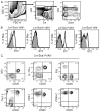Lineage(-)Sca1+c-Kit(-)CD25+ cells are IL-33-responsive type 2 innate cells in the mouse bone marrow
- PMID: 22048767
- PMCID: PMC4449734
- DOI: 10.4049/jimmunol.1102242
Lineage(-)Sca1+c-Kit(-)CD25+ cells are IL-33-responsive type 2 innate cells in the mouse bone marrow
Abstract
IL-33 promotes type 2 immune responses, both protective and pathogenic. Recently, targets of IL-33, including several newly discovered type 2 innate cells, have been characterized in the periphery. In this study, we report that bone marrow cells from wild-type C57BL/6 mice responded with IL-5 and IL-13 production when cultured with IL-33. IL-33 cultures of bone marrow cells from Rag1 KO and Kit(W-sh/W-sh) mice also responded similarly; hence, eliminating the possible contributions of T, B, and mast cells. Rather, intracellular staining revealed that the IL-5- and IL-13-positive cells display a marker profile consistent with the Lineage(-)Sca-1(+)c-Kit(-)CD25(+) (LSK(-)CD25(+)) cells, a bone marrow cell population of previously unknown function. Freshly isolated LSK(-)CD25(+) cells uniformly express ST2, the IL-33 receptor. In addition, culture of sorted LSK(-)CD25(+) cells showed that they indeed produce IL-5 and IL-13 when cultured with IL-33 plus IL-2 and IL-33 plus IL-7. Furthermore, i.p. injections of IL-33 or IL-25 into mice induced LSK(-)CD25(+) cells to expand, in both size and frequency, and to upregulate ST2 and α(4)β(7) integrin, a mucosal homing marker. Thus, we identify the enigmatic bone marrow LSK(-)CD25(+) cells as IL-33 responsive, both in vitro and in vivo, with attributes similar to other type 2 innate cells described in peripheral tissues.
Conflict of interest statement
The authors have no financial conflicts of interest.
Figures







References
-
- Schmitz J, Owyang A, Oldham E, Song Y, Murphy E, McClanahan TK, Zurawski G, Moshrefi M, Qin J, Li X, et al. IL-33, an interleukin-1-like cytokine that signals via the IL-1 receptor-related protein ST2 and induces T helper type 2-associated cytokines. Immunity. 2005;23:479–490. - PubMed
-
- Liew FY, Pitman NI, McInnes IB. Disease-associated functions of IL-33: the new kid in the IL-1 family. Nat Rev Immunol. 2010;10:103–110. - PubMed
Publication types
MeSH terms
Substances
Grants and funding
LinkOut - more resources
Full Text Sources
Molecular Biology Databases
Research Materials

